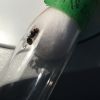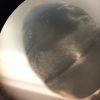Hi All Again
Western Canada is having a heat wave which has helped me find a number of queens right after flights. I have found 3 species in the last week and even 3 different queen species today. One if Formica but the two new ones today I would appreciate any help you can give IDing? See pics and descriptions below;
Queen 1
1,Location of collection: Victoria BC Canada. Esquimalt on sidewalk.
2. Date of collection: June 25th/2017 Found 5 queens over the day. Most around 9am. 28 degrees Celsius aprox 41% humidity.
3. Habitat of collection: Paver driveway and sidewalk. Urban area
4. Length (from head to gaster):7-8mm
5. Color, hue, pattern and texture: Shinny black head and thorax,red/orange legs, with a black and orange stripe Gaster, hear on head and body, red jaws,
6. Distinguishing characteristics: 2 spikes pointing backwards on the thorax, 2 part petiole with one closest to thorax a pump and second one rounded.
7. Distinguishing behavior: All queens walk oddly compared to other ants appearing to drag gasters.
8. Nest description: Unknown
Pics;
Queen 2
1,Location of collection: Victoria BC Canada Esquimalt . Crossing driveway. Very fast and aggressive ant.
2. Date of collection: June 25th/2017 Found 1 queen at 7;30pm. 23 degrees Celsius aprox 41% humidity.
3. Habitat of collection: Paver driveway. Urban area
4. Length (from head to gaster):10mm
5. Color, hue, pattern and texture: Red/Orange read and thorax. Black legs. Black Gasters. 11 segments per antenna.Large single red spike petiole.
6. Distinguishing characteristics: see pics and above.
7. Distinguishing behaviour: Fast and peered very aggrieve when capturing.
8. Nest description: Unknown
Pics;

















